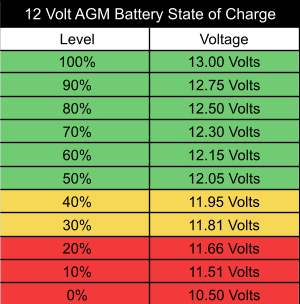Maintaining your deep cycle batteries is essential to ensure a maximum life span and to prevent damage. As such, it is important to detect battery problems at an early stage. Troubleshooting deep cycle battery issues is fairly easy to do yourself with the aid of a multimeter, volt meter, or watt meter. Read more
Your battery will need to be fully charged before its first use, we recommend a AC (240V) charger to do this. The charger should be a minimum of a 10amp lithium specific charger or a 15amp AGM/Lead acid charger. This helps to calibrate the onboard BMS (battery management system), which handles the safety features of your battery.
Do not directly connect a solar panel to the battery, instead use a suitable SOLAR REGULATOR.
Do not charge directly from an alternator, instead use a DCDC charger to charge from your vehicle.
Follow the charging instructions on front of battery. Bulk charge 14.4V-14.7V, Float charge 13.6V-13.8V. Please also keep in mind that a resting voltage of at least 13.4V is considered fully charged. 12.9V is approximately 20% charged and at this point, we recommend recharging your battery to avoid it going flat.
If the battery does completely go flat and the BMS enters sleep mode, please use the guide on the below link to restart your battery: Download PDF
For your AGM battery the charging rate is 14.7v
State of charge
Battery chargers have come a long way in recent years with the coming of age of “smart” chargers. These chargers can automatically detect the type of battery being charged (Flooded, AGM or GEL) and charge them appropriately.
They start by being connected to the battery and then send a pulse into the battery to determine the internal resistance of the battery. From this it will know the type of battery being charged and will charge it at the voltage that best suits that type of battery.
These smart chargers are usually staged and will usually have a “float” charge as its final stage allowing the user to not worry about the battery being overcharged or when they must remove the battery from the charger. When using an older charger, it’s important that the charger be compatible with the type of battery you are charging. If you charge an AGM battery with a charger designed to charge wet cell batteries alone, it will overcharge the AGM and damage it, shortening its life span. As a rough guide battery chargers should be rated at 10% of the AH capacity of the battery that it’s charging. For example, if you are charging a 100AH battery, then a battery charger rated to 10amps would be the ideal size to charge it. Up to 5% either side of this 10% figure is fine but placing a small battery charger on a large battery or battery bank may take it too long to charge or it may never reach full charge and placing a charger that’s too large for a battery can cause it to charge too quickly and cause damage to the battery.
YES - in fact, any type of deep cycle battery can be charged with solar panels. Make sure to use a solar charge controller for deep cycle solar batteries to regulate the charge or add an Ardent Battery Box with Anderson Plug Connections.
**An Anderson style plug is a moulded, heavy-duty connector designed for high current 12V circuits. They are commonly used to create a safe and secure power connection between a battery and the solar panels. Indeed, most caravans and campers these days have Anderson style plugs installed from the factory.
For Lithium Deep Cycle Batteries, you need to make sure the open voltage of the solar panel is below 18V for a 12V battery. It is best if your solar panel has a voltage regulator to stop charging at 14.4V or (LiFePO4) setting of 14.6V.
NO - Deep cycle batteries aren’t designed to deliver high currents to start a car. Using one could damage the battery or the car. Make sure you stick to a starting battery for this purpose.
NO - Try to only connect batteries of the same type, model, capacity, and age. For example, if you want to connect your deep cycle battery with another one to increase power output, make sure the second battery meets the mentioned criteria.